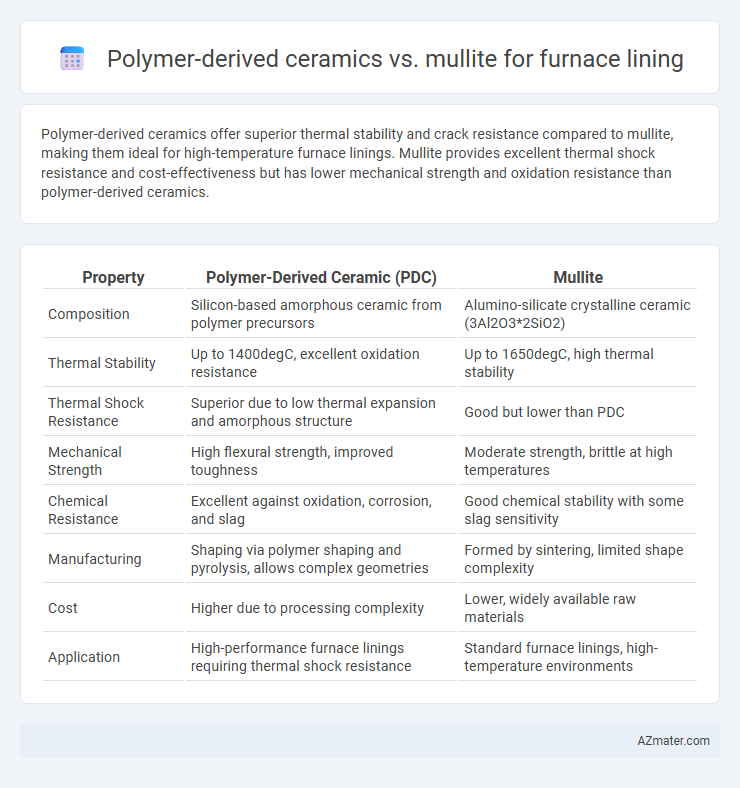Polymer-derived ceramics offer superior thermal stability and crack resistance compared to mullite, making them ideal for high-temperature furnace linings. Mullite provides excellent thermal shock resistance and cost-effectiveness but has lower mechanical strength and oxidation resistance than polymer-derived ceramics.
Table of Comparison
| Property | Polymer-Derived Ceramic (PDC) | Mullite |
|---|---|---|
| Composition | Silicon-based amorphous ceramic from polymer precursors | Alumino-silicate crystalline ceramic (3Al2O3*2SiO2) |
| Thermal Stability | Up to 1400degC, excellent oxidation resistance | Up to 1650degC, high thermal stability |
| Thermal Shock Resistance | Superior due to low thermal expansion and amorphous structure | Good but lower than PDC |
| Mechanical Strength | High flexural strength, improved toughness | Moderate strength, brittle at high temperatures |
| Chemical Resistance | Excellent against oxidation, corrosion, and slag | Good chemical stability with some slag sensitivity |
| Manufacturing | Shaping via polymer shaping and pyrolysis, allows complex geometries | Formed by sintering, limited shape complexity |
| Cost | Higher due to processing complexity | Lower, widely available raw materials |
| Application | High-performance furnace linings requiring thermal shock resistance | Standard furnace linings, high-temperature environments |
Introduction to Furnace Lining Materials
Polymer-derived ceramics offer superior thermal stability and resistance to high-temperature corrosion compared to traditional mullite, making them ideal for advanced furnace lining applications. Mullite, a naturally occurring aluminosilicate, provides excellent thermal shock resistance and mechanical strength, widely used in industrial furnace linings operating up to 1700degC. The choice between polymer-derived ceramics and mullite depends on factors like operating temperature, chemical environment, and mechanical stress requirements in furnace lining designs.
Overview of Polymer-Derived Ceramics
Polymer-derived ceramics (PDCs) are advanced materials synthesized through the pyrolysis of preceramic polymers, offering superior thermal stability and oxidation resistance compared to traditional furnace lining materials like mullite. These ceramics exhibit enhanced mechanical strength, lower porosity, and improved thermal shock resistance, making them ideal for high-temperature furnace applications. The ability to tailor the chemical composition at the molecular level allows PDCs to achieve optimized performance in aggressive furnace environments, outperforming conventional mullite linings in durability and lifespan.
Key Properties of Mullite in Furnace Applications
Mullite exhibits exceptional thermal stability and low thermal expansion, making it ideal for furnace lining under high-temperature conditions. Its excellent resistance to thermal shock and chemical corrosion ensures long-lasting performance in harsh environments. The material's mechanical strength and structural integrity at elevated temperatures support efficient heat retention and durability in industrial furnace applications.
Thermal Stability: Polymer-Derived Ceramics vs Mullite
Polymer-derived ceramics exhibit superior thermal stability compared to mullite, maintaining structural integrity at temperatures exceeding 1600degC, whereas mullite typically withstands up to 1500degC. The unique microstructure of polymer-derived ceramics offers enhanced resistance to thermal shock and prolonged high-temperature exposure. This makes polymer-derived ceramics a more reliable choice for furnace linings subjected to extreme thermal cycling and harsh environments.
Chemical Resistance Comparison
Polymer-derived ceramics exhibit superior chemical resistance compared to mullite in furnace lining applications, particularly against harsh environments containing alkalis and acidic vapors, due to their dense amorphous to nanocrystalline microstructure. Mullite, while stable at high temperatures and resistant to thermal shock, tends to degrade more rapidly when exposed to aggressive chemical agents, leading to compromised furnace integrity over time. The enhanced chemical durability of polymer-derived ceramics extends furnace lifespan and reduces maintenance costs by minimizing corrosion-related damage in chemically reactive atmospheres.
Mechanical Strength and Durability
Polymer-derived ceramics (PDCs) exhibit superior mechanical strength and enhanced thermal shock resistance compared to traditional mullite, making them highly suitable for furnace lining applications. PDCs maintain structural integrity at elevated temperatures due to their amorphous to nano-crystalline microstructure, whereas mullite's crystalline nature limits its toughness under rapid thermal cycling. The superior durability of PDCs under harsh furnace conditions results in longer service life and reduced maintenance costs relative to mullite-based linings.
Fabrication and Installation Considerations
Polymer-derived ceramics offer superior fabrication flexibility compared to mullite, allowing for complex shapes and intricate designs through processes like polymer infiltration and pyrolysis, which reduces machining time and waste. Mullite, known for its excellent thermal stability, requires conventional ceramic forming techniques such as pressing and sintering, often resulting in longer production cycles and limited geometrical adaptability. Installation of polymer-derived ceramic linings can be more efficient due to their lightweight nature and precise fit, whereas mullite linings demand careful handling because of their brittleness and higher density, impacting labor and downtime during furnace maintenance.
Cost Analysis: Polymer-Derived Ceramics vs Mullite
Polymer-derived ceramics (PDCs) offer enhanced thermal shock resistance and longer service life compared to mullite, potentially reducing overall maintenance costs despite higher initial material expenses. Mullite remains cost-effective upfront due to its widespread availability and lower raw material costs, making it favorable for budget-sensitive furnace lining projects. Lifecycle cost analysis often favors PDCs when factoring in energy savings and downtime reduction in high-performance applications.
Industry Applications and Case Studies
Polymer-derived ceramics (PDCs) offer superior thermal shock resistance and chemical stability compared to traditional mullite, making them ideal for furnace linings in harsh industrial environments such as metal casting and glass production. Industry case studies highlight PDCs' enhanced durability under cyclic thermal loads, reducing maintenance costs and downtime in petrochemical and aerospace manufacturing. Mullite remains favored for its cost-effectiveness and excellent high-temperature insulation, but PDCs increasingly dominate applications requiring extended furnace lifespan and improved thermal performance.
Future Trends in Furnace Lining Technologies
Polymer-derived ceramics (PDCs) are emerging as a transformative material in furnace lining technology, offering superior thermal stability, oxidation resistance, and mechanical strength compared to traditional mullite linings. Future trends highlight the integration of nano-engineered PDC composites to enhance crack resistance and thermal shock performance, enabling longer furnace lifespans and reduced maintenance costs. Advances in additive manufacturing also allow precise tailoring of PDC-based furnace linings, optimizing heat insulation and energy efficiency beyond the capabilities of conventional mullite materials.

Infographic: Polymer-derived ceramic vs Mullite for Furnace lining
 azmater.com
azmater.com